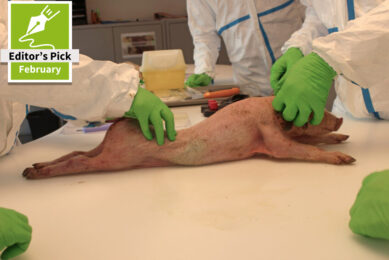Insights from microbial surveillance in broiler flocks

Well-designed microbial surveillance programmes can identify risk factors, guide treatment strategies, and illuminate differences in pathogenic microbial populations in high- and low-performing broiler flocks.
Microbial surveillance research in broiler production may take many forms. Whether microbial surveillance programmes focus on the environment, the litter, or the bacteria of the intestinal tract, they come with an ambitious promise: to identify the most relevant pathogens present in a flock, to characterise them in ways that matter, and to guide decision-making about feeding strategies and management practices.
Microbial profiles
With all microbial surveillance programmes, sampling strategy matters. Bacteria in the GIT vary widely in environmental needs, hardiness, and survivability under various conditions, a fresh gut sample contains a wider variety of fragile anaerobic bacteria than a litter sample exposed to air for hours, and even within the gut, microbial profiles vary by section due to pH, oxygenation level, and nutrient availability.
Microbial surveillance based on DNA
DNA-based microbial surveillance is a culture-independent tool which provides a snapshot of the microbes present in a sample at the time of sample capture and preservation. A properly handled sample preserves the DNA of all microbes present in a sample, regardless of their fragility, viability, or growth requirements in the lab and can be tested for gene sequences from a wide variety of microbes.
DNA-based microbial surveillance can identify microbial issues by identifying specific virulence genes carried by pathogenic strains and serotypes of different species. For example, an avian pathogenic E. coli strain carrying virulence genes involved in acute colibacillosis or a Clostridium perfringens strain capable of producing the toxin involved in necrotic enteritis present very different health hazards than other commensal strains likely to be present in the gut. Knowing virulence types can provide insight into the disease processes affecting performance.
Surveillance designed for poultry
Expanding on their success in other livestock markets, United Animal Health has developed a microbial surveillance programme for poultry, beginning with a large study of broiler producers in important poultry-producing regions of the US. Screening samples for a broad range of microbial targets using high-throughput technologies, they have used molecular methods to investigate differences in virulence gene carriage in the broiler gastrointestinal tract. Samplings were conducted onsite at grow-out farms, covering houses with differences in health or performance. Swab samples were collected from multiple gut sections of representative birds, stabilised on-site for preservation of microbial DNA, and assessed for the presence and quantity of relevant microbial virulence genes by quantitative PCR. Analysis of this data uncovered significant differences in the clusters of E. coli and C. perfringens virulence genes present in the caeca of healthy, undersized, and sick birds, as well as similar trends in food safety-related organisms including Campylobacter and Salmonella. The survey included 77 farms from 18 broiler production complexes in 12 states and sampled undersized birds from healthy flocks, sick birds from high-mortality flocks, and healthy, high-performing birds from all flocks. Clostridial disease was the most frequently reported health challenge in high-mortality flocks. In total, caecal swabs from 571 birds ranging from 1 to 42 days of age were used for analysis of bacterial virulence genes. Avian pathogenic E. coli (APEC) carrying a specific set of virulence genes associated with extraintestinal infection and tissue damage in birds predominated in sick birds from high-mortality flocks. Small, underperforming birds in healthy flocks carried significantly higher levels of non-APEC E. coli with a different set of intestinal virulence factors (eaeA and EAST1) involved in attachment, tissue damage, and aggregation on the intestinal wall (Figure 1).
Figure 1 – Average quantities of virulence genes from health-related microorganisms in caecal samples from healthy, undersized, and sick birds.

Microbial population in health-challenged birds
Similar trends were seen with other species involved in broiler health or food safety concerns. C. perfringens and its necrotic enteritis-associated toxin gene netB were significantly elevated in sick birds from high-mortality flocks, where necrotic enteritis or other clostridial disease was the most frequent concern. Secondary C. perfringens virulence genes associated with disease in other monogastrics were found very rarely in the survey but were also significantly elevated in sick birds in high-mortality flocks. C. septicum, a cause of gangrenous dermatitis and other myonecrotic infections, was also significantly elevated in sick birds from high-mortality flocks. Neither C. perfringens nor C. septicum differed between healthy birds and small, underperforming birds, suggesting a more limited role in subclinical performance drag than the association seen with non-APEC, toxigenic E. coli. Carriage of microorganisms involved in food safety, such as Campylobacter and Salmonella, was also increased in the dysbiotic gut. Total Campylobacter and C. jejuni were significantly more common in the caeca of sick birds than in undersized birds from healthy flocks (Figure 2). Salmonella was detected at much lower levels than Campylobacter in the flocks surveyed, but carriage trended slightly higher in birds with compromised health. More than one microbial population was often elevated in health-challenged birds, reflecting a broader dysbiosis allowing opportunistic overgrowth by multiple organisms.
Figure 2 – Average quantities of marker genes for food safety-related microorganisms in caecal samples from healthy, undersized, and sick birds.

Guide for producers
Microbial surveillance programmes may guide the decisions of individual producers, particularly in the area of feed additives. Findings may aid in the selection of an effective direct-fed microbial product, prioritising products that incorporate unique strains with the right characteristics for specific microbial challenges. Furthermore, analysis of microbial profiles in important poultry-producing regions worldwide can guide product development and innovation by identifying important microorganisms in challenged or underperforming flocks, uncovering the source of subclinical performance drags, understanding microbial differences linked to regional differences in diet and management, and focusing next-generation product development on unmet needs in the industry.
Author:
Amy Lange, Microbiologist, United Animal Health







